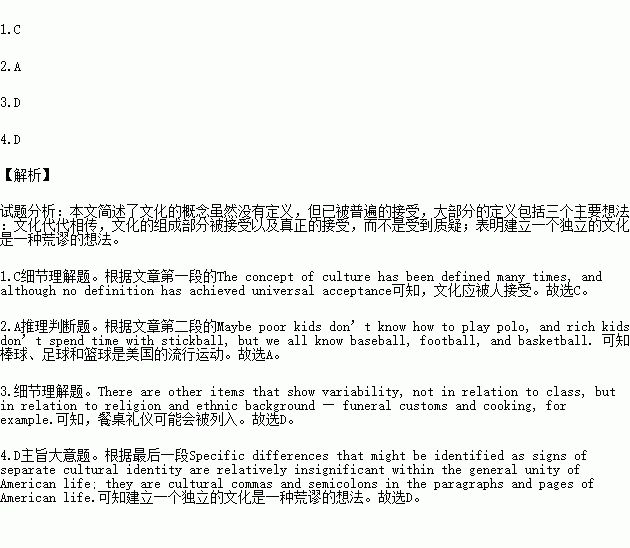题目内容
The concept of culture has been defined many times, and although no definition has achieved universal acceptance, most of the definitions include three central ideas: that culture is passed on from generation to generation, that a culture represents a ready-made principle for living and for making day-to-day decisions, and, finally, that the components of a culture are accepted by those in the culture as good, and true, and not to be questioned. The eminent anthropologist George Murdock has listed seventy-three items that characterize every known culture, past and present.
The list begins with Age-grading and Athletic sports, runs to Weaning and Weather Control, and includes on the way such items as Calendar, Fire making, Property Rights, and Tool making. I would submit that even the most extreme advocate of a culture of poverty viewpoint would readily acknowledge that, with respect to almost all of these items, every American, beyond the first generation immigrant, regardless of race or class, is a member of a common culture. We all share pretty much the same sports. Maybe poor kids don’t know how to play polo, and rich kids don’t spend time with stickball, but we all know baseball, football, and basketball. Despite some misguided efforts to raise minor dialects to the status of separate tongues, we all, in fact, share the same language.
There may be differences in diction and usage, but it would be ridiculous to say that all Americans don’t speak English. We have the calendar, the law, and large numbers of other cultural items in common. It may well be true that on a few of the seventy-three items there are minor variations between classes, but these kinds of things are really slight variations on a common theme.
There are other items that show variability, not in relation to class, but in relation to religion and ethnic background — funeral customs and cooking, for example. But if there is one place in America where the melting pot is a reality, it is on the kitchen stove; in the course of one month, half the readers of this sentence have probably eaten pizza, hot pastrami, and chow mein. Specific differences that might be identified as signs of separate cultural identity are relatively insignificant within the general unity of American life; they are cultural commas and semicolons in the paragraphs and pages of American life.
1.According to the author’s definition of culture, ________.
A. a culture should be accepted and maintained universally
B. a culture should be free from falsehood and evils
C. the items of a culture should be taken for granted by people
D. the items of a culture should be accepted by well-educated people
2.What can we learn from the passage?
A. Baseball, football and basketball are popular sports in America.
B. Different classes have different cultures.
C. Playing polo is popular among kids.
D. There is no variation in using the American language.
3.It can be inferred that ________ will most probably be included in the seventy-three items.
A. accent | B. polo | C. dream patterns | D. table manners |
4.The author’s main purpose in writing this passage is to ________.
A. prove that different people have different definitions of culture
B. warn that variations exist as far as a culture is concerned
C. indicate that culture is closely connected with social classes
D. show that the idea that the poor or the rich establish a separate culture is an absurdity

